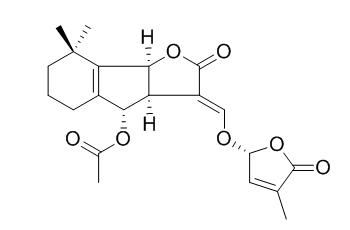Orobanchyl acetate
Orobanchyl acetate is a germination stimulant for root parasitic plants.
Inquire / Order:
manager@chemfaces.com
Technical Inquiries:
service@chemfaces.com
Tel:
+86-27-84237783
Fax:
+86-27-84254680
Address:
1 Building, No. 83, CheCheng Rd., Wuhan Economic and Technological Development Zone, Wuhan, Hubei 430056, PRC
Providing storage is as stated on the product vial and the vial is kept tightly sealed, the product can be stored for up to
24 months(2-8C).
Wherever possible, you should prepare and use solutions on the same day. However, if you need to make up stock solutions in advance, we recommend that you store the solution as aliquots in tightly sealed vials at -20C. Generally, these will be useable for up to two weeks. Before use, and prior to opening the vial we recommend that you allow your product to equilibrate to room temperature for at least 1 hour.
Need more advice on solubility, usage and handling? Please email to: service@chemfaces.com
The packaging of the product may have turned upside down during transportation, resulting in the natural compounds adhering to the neck or cap of the vial. take the vial out of its packaging and gently shake to let the compounds fall to the bottom of the vial. for liquid products, centrifuge at 200-500 RPM to gather the liquid at the bottom of the vial. try to avoid loss or contamination during handling.
Aging (Albany NY).2023, 15(24):15557-15577.
The Pharmaceutical Society of Japan2018, 138(4):571-579
J Ethnopharmacol.2018, 210:88-94
Journal of Functional Foods2017, 30:30-38
Int J Cosmet Sci.2023, 45(2):155-165.
Microchemical Journal2014, 203:110804.
Nutrients.2018, 10(12):E1998
Food Chem Toxicol.2023, 176:113802.
Biomedicines.2022, 10(2):463.
Int J Mol Sci.2019, 20(23):E6071
Related and Featured Products
New Phytologist, 2008, 179(2):484.
Strigolactones, host recognition signals for root parasitic plants and arbuscular mycorrhizal fungi, from Fabaceae plants.[Pubmed:
19086293]
Both root parasitic plants and arbuscular mycorrhizal (AM) fungi take advantage of strigolactones, released from plant roots as signal molecules in the initial communication with host plants, in order to commence parasitism and mutualism, respectively.
METHODS AND RESULTS:
In this study, strigolactones in root exudates from 12 Fabaceae plants, including hydroponically grown white lupin (Lupinus albus), a nonhost of AM fungi, were characterized by comparing retention times of germination stimulants on reverse-phase high-performance liquid chromatography (HPLC) with those of standards and by using tandem mass spectrometry (LC/MS/MS). All the plant species examined were found to exude known strigolactones, such as orobanchol, Orobanchyl acetate, and 5-deoxystrigol, suggesting that these strigolactones are widely distributed in the Fabaceae. It should be noted that even the nonmycotrophic L. albus exuded orobanchol, Orobanchyl acetate, 5-deoxystrigol, and novel germination stimulants. By contrast to the mycotrophic Fabaceae plant Trifolium pratense, in which phosphorus deficiency promoted strigolactone exudation, neither phosphorus nor nitrogen deficiency increased exudation of these strigolactones in L. albus.
CONCLUSIONS:
Therefore, the regulation of strigolactone production and/or exudation seems to be closely related to the nutrient acquisition strategy of the plants.
Phytochemistry. 2008 Jan;69(2):427-31.
Isolation and identification of alectrol as (+)-orobanchyl acetate, a germination stimulant for root parasitic plants.[Pubmed:
17822727]
METHODS AND RESULTS:
Alectrol, a germination stimulant for root parasitic plants, was purified from root exudates of red clover (Trifolium pratense L.) and identified as a strigolactone, ( )-Orobanchyl acetate [(3aS,4S,8bS,E)-8,8-dimethyl-3-(((R)-4-methyl-5-oxo-2,5-dihydrofuran-2-yloxy)methylene)-2-oxo-3,3a,4,5,6,7,8,8b-octahydro-2H-indeno[1,2-b]furan-4-yl acetate], by 1D and 2D NMR spectroscopy and ESI- and EI-MS spectrometry. Orobanchyl acetate afforded an [M-42]( ) ion in EI-MS and thus had been recognized as an isomer of strigol.
CONCLUSIONS:
Orobanchyl acetate was detected in root exudates of soybean (Glycine max L.) and cowpea (Vigina unguiculata L.) along with orobanchol.



